Scientists estimate that we reached Peak Superhero in the summer of 2008, when “The Dark Knight” sucked the attention of every critic, pundit and sentient moviegoer into its inky nexus. It is not as if the number of movies featuring troubled guys wearing costumes and fighting evil has diminished since then. Quite the contrary. But the genre, though it is still in a period of commercial ascendancy, has also entered a phase of imaginative decadence.
A.O. Scott, “Review: The Avengers,” The New York Times, 5/3/12
The decline in U.S. oil production is explained by the Hubbert Peak Theory, which states that “the amount of oil under the ground in any region is finite, therefore the rate of discovery which initially increases quickly must reach a maximum and decline.” Makes sense, right? The same theory can apply to anything of a finite quantity that is discovered and quickly exploited with maximum effort. Including, it would seem, rock & roll.
Mark Lee, “The Hubbert Peak Theory of Rock,” OverthinkingIt.com, 9/23/08
In the summer of 2012, we saw two monumental achievements in superhero movies. Both The Avengers and The Dark Knight Rises capitalized on almost decade-long buildups to smash box office records and win widespread (though not universal) critical acclaim. In the wake of these two movies, both slack-jawed fanboys and jaded critics alike are asking questions like the following:
“Where do we go from here?”
“How can the movie studios top these achievements while recycling the same first-tier characters and trotting out second- and third-tier characters?”
“Will audiences retain their appetite for superhero movies, or have they had enough?”
In other words, have we reached Peak Superhero, the point where we’ve maximized the exploitation of a finite resource and are now entering a period of inexorable decline?

In the above-quoted piece, “The Hubbert Peak Theory of Rock,” I demonstrated how Peak Theory could be applied to a related field of creative works. The basic idea is that there’s a finite supply of the “really good/innovative stuff” (in the case of rock music, Elvis – > The Beatles – > Bob Dylan – > Led Zeppelin), and that after its initial discovery and rapid exploitation, the rate of production will peak and eventually decline over time (Third Eye Blind – > Creed).
Peak Theory is, at best, an interesting yet problematic way of analyzing pop culture. I encourage you to read the original article and its comments to get a sense of the limitations of this approach. That being said, I still believe that applying Peak Theory to pop culture analysis helps us think critically about the limitations that genre and art form definitions place on creative works.
So with that, let’s establish a Peak Superhero hypothesis and subject it to some fun statistical analysis.
Hypothesis
Let’s put this series of assertions to the test:
There is a finite supply of quality, mass appeal superhero movies that Marvel and DC can produce. The supply of first-tier comic book characters is finite and not growing, as evinced by Marvel and DC’s failure to produce a new character with the same cultural impact along the lines of Spider-Man, Batman, Superman, the X-Men, and their peers. Because there is this finite supply of first-tier characters, there is also a finite supply of quality movies with mass appeal that movie studios can make based on these characters. There is also a finite amount of time that these movies can maintain such a high level of prominence in the pop culture zeitgeist. As a result of these limitations, critical and audience approval of these movies will eventually peak, then decline, as will the production of these movies.
Methodology for Testing Hypothesis
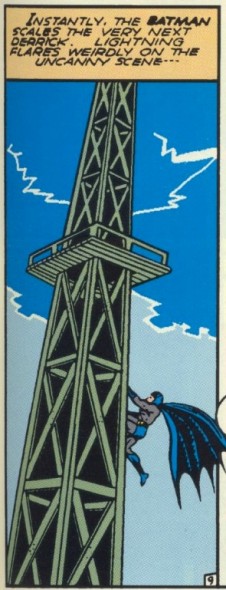 To test this hypothesis, I assembled a dataset of 49 DC and Marvel superhero movies, starting with Superman (1978) and ending with The Dark Knight Rises (2012). I started with these Wikipedia lists of movies based on Marvel and DC Comics and excluded anything that was direct to video.
To test this hypothesis, I assembled a dataset of 49 DC and Marvel superhero movies, starting with Superman (1978) and ending with The Dark Knight Rises (2012). I started with these Wikipedia lists of movies based on Marvel and DC Comics and excluded anything that was direct to video.
To measure quality of these movies, as determined by critics and audiences, I gave each movie a composite IMDB + Rotten Tomatoes score by converting the IMDB rating to a 1-100 scale and averaging the two.
To measure viewership of these movies, I calculated opening weekend attendance based on box office receipts and average movie ticket prices at the time. I also calculated the percent of the total US population at the time who saw these movies during their opening weekends, based on the above attendance calculation and annual US Census population estimates. (Note: I know there are plenty of issues with the methodology in this area; I acknowledge them below.)
To measure overall trends over time, I calculated average ratings and attendance numbers across all movies in a given year. I also applied a third order polynomial trend line to the data to get a sense of both upward and downward trends over the years.
And then I made a lot of graphs.
Production of Superhero Movies
First, let’s take a look at the rate of production of DC and Marvel Superhero movies since 1978:
Although A.O. Scott didn’t present any statistics or graphs with his assertion that superhero movie production has continued its increase since 2008, he was absolutely right. The trend remains solidly upward.
This graph, though an interesting quantification of superhero movie production, actually doesn’t tell us much about Peak Superhero. Because we can’t actually prove that there’s anything finite about the supply of superhero movies or their quality, we’re forced to look for evidence of this in retroactive analysis of the numbers. In other words, in order to say that Peak Theory is in play, we need to have evidence of a peak. And in order to have evidence of a peak, we need to have evidence of some sort of decline. And there’s no evidence of decline, or even plateau, for that matter, in the production of superhero movies based on the data.
Now, let’s look for evidence of Peak Superhero in Quality and Attendance:
Quality of Superhero Movies
I used the average IMDB + Rotten Tomatoes composite scores for superhero movies per year to see if there are any trends in superhero movie quality over time:
“Aha! Look at the fall/rise/fall pattern! Peak Superhero was in 2008/The Dark Knight after all!”
Not so fast. The R squared value, which is indicative of the strength of the correlation between year and score, is pretty low, which means that strength of any trend that you can extrapolate from this view is going to be fairly weak. More importantly, when you intuitively consider the trend over the last few years since The Dark Knight, any assertion that the critical/fan consensus on big superhero movies has entered inexorable decline just doesn’t hold water. A.O. Scott may complain about the “imaginative decadence” of The Avengers, but the aggregated opinions of the commentariat do not seem to agree with him when it comes to that movie or The Dark Knight Rises.
Again, as was the case with production, quality shows no evidence of Peak Superhero. There’s no decline, hence, no peak.
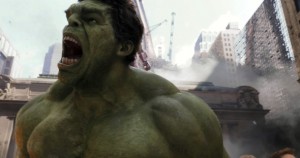
HULK SMASH MOVIE CRITICS WHO CALL THIS ‘IMAGINATIVE DECADENCE’!
Opening Weekend Attendance for Superhero Movies
Before we dive into this data, I need to make very clear some important caveats around this particular part of the methodology. First, regarding attendance data: as I mentioned above, I calculated this by dividing the opening weekend box office gross by the average movie ticket price for that year. Although BoxOfficeMojo.com also uses this method, they acknowledge that it’s only good for getting a general sense of movie attendance and is not an exact science.
Second, regarding attendance as a portion of the overall US population: this is my best attempt at measuring the extent that superhero movies saturated the popular culture for any given year. That being said, I started with the already inexact attendance data, and I divided by the total population of the United States, without any regard to size of movie audience or demographic shifts.
Third, these attendance statistics reflect opening weekends in the United States only. They disregard attendance outside of opening weekends and all attendance outside of the United States. That being said, this is probably the best (and only) way to get apples-to-apples comparisons for all of the movies in the dataset.
Okay. With all of those caveats out of the way, let’s see if there’s any indication that the audience for superhero movies has peaked, either in absolute terms or relative terms.
Let’s get the most obvious question out of the way. Total opening weekend audiences for superhero movies follow an overall upward trend. But this should be of no surprise, given that the production of these movies is also on an upward trend. More movies = larger audience.
Average opening weekend audiences (by film, by year) also follow an upward trend, although not nearly as strong of one as total opening weekend audiences:
Now let’s look at average opening weekend audiences (by film, by year) as a percent of the total US population for each year:
This does flatten out the trend by a little bit. Note that in absolute terms, the biggest year for average opening weekend audience for superhero movies was 2012, but as a portion of the total population, that high point becomes 1995. Yup, Batman Forever was a freaking huge movie at the time.
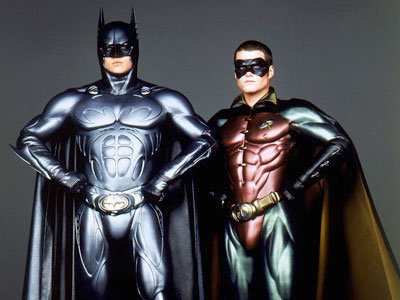
Val Kilmer and Chris O’Donnell as Batman and Robin in “Batman Forever,” 1995. This happened.
(Remember, we’re talking about annual averages, not annual totals. “Batman Forever” was the only major superhero movie in 1995, and 4.62% of the US population went to see it during its opening weekend. In 2012, there were four major superhero movies (Ghost Rider: Spirit of Vengeance, The Avengers, The Amazing Spider-Man, and The Dark Knight Rises), and an average of 4.55% of the US population saw those movies during their respective opening weekends.)
But back to the matter at hand. Is there any evidence of Peak Superhero to be found? Again, the answer is no. Even if the last graph shows a flatter trend, it shows no evidence of a consistent decline or well-defined peak. Oh, and that R squared value is also pretty low.
Conclusion (to the extent that anything is actually concluded)
Have we reached Peak Superhero?
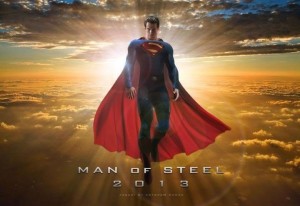
Zak freaking Snyder is directing this, ladies and gentlemen. Zak freaking Snyder.
Maybe, but it’s too early to tell without any solid indicators of a decline in superhero movie production, quality, or audience. At the appropriate time in the future, we’ll revisit these statistics and respond to reader ideas for alternate ways of crunching the numbers. Until then, we should further scrutinize the statistics, but we should also be scrutinizing the genre of the superhero movie as an art form as well. Seriously, where do we go from here? Marvel can’t possibly replicate the pent-up demand for the first Avengers movie. And even with Christopher Nolan producing the new Superman movie and providing creative input, I highly doubt that director Zak Snyder will be able to approach the levels of commercial and critical achievement of the now-complete Batman trilogy.
Let’s go back to Peak Theory to wrap things up. When I present these analyses of pop culture through the lens of this theory, I’m not actually saying that, like natural resources, a given art form has a finite supply, and that commercial/creative decline inevitably follows a peak. Consider, however, that the nature of the entertainment business is such that it encourages rapid exploitation of new art forms and that it expects that past successes can be repeated by copying the last formula for success, with just a few tweaks here and there. And again, consider that there actually does appear to be a finite supply of top-tier superhero characters.
All this leads me to say that, just as you shouldn’t count on an infinite supply of cheap fossil fuels to get your car to the cineplex weekend after weekend, you shouldn’t count on a never-ending string of future superhero successes like The Avengers and The Dark Knight Rises.
—
Readers: Want to do your own number crunching? Download this dataset, fire up your copy of Excel, and share your handiwork in the comments! If you do so, some things to consider as you analyze the data:
- BoxOfficeMojo was missing opening weekend box office data for 3 movies: The Swamp Thing, The Return of the Swamp Thing, and the 1989 Punisher movie. If anybody can dig those up and demonstrate that they’re consistent with the rest of the dataset, let me know and I’ll factor them back into the dataset.
- This dataset treated all movies equally, so Howard the Duck and Ghost Rider are given the same consideration as X-Men and The Dark Knight. I’d be interested to see if someone can conduct analysis using a subset of first-tier only superhero movies (which I’ve defined as X-Men, Spider-Man, Superman, and Batman, though you’re free to offer different definitions of that subset).
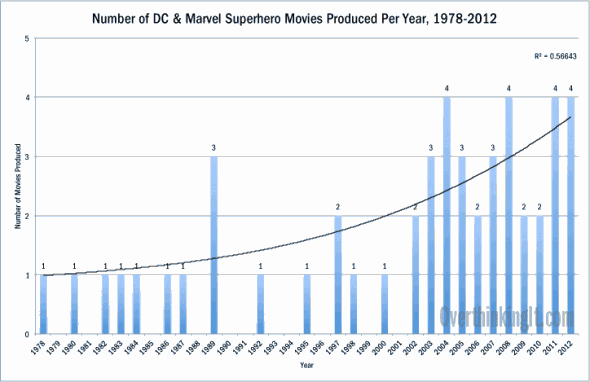
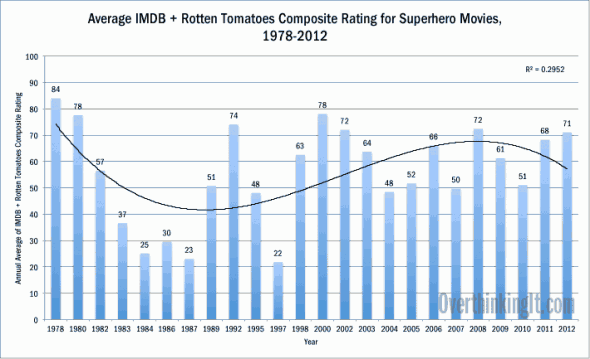
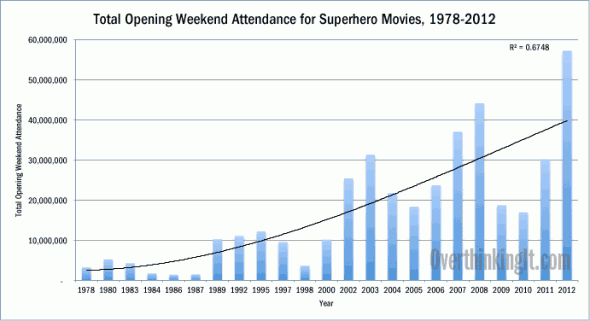
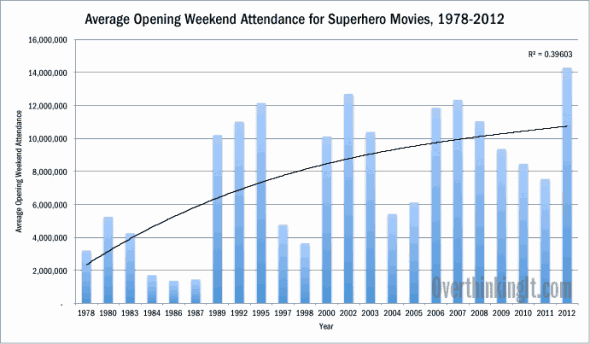
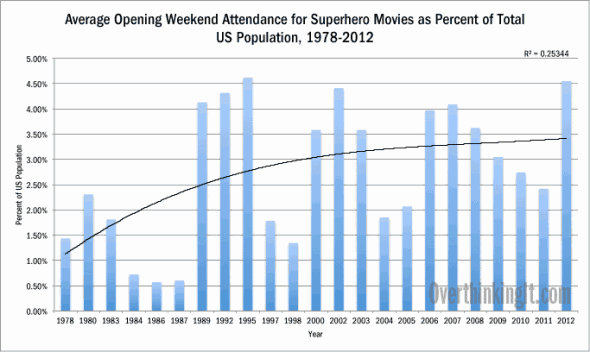
It’s a very interesting thought thread, but I think it’s inappropriate to simply look at it from a ‘numbers’ perspective. I mean, Avatar made more money than the New York Yankees spent that year and I thought it was trash. Quality done consistently begets viewership (for the most part). Since Batman Begins, people have been taking superhero films considerably more seriously. Those people being Hollywood. 2008’s Iron Man surprised everyone: it was a little known (in the movie mainstream) character portrayed by a has-been barely-B-lister who shot back to the A-list because of that film. Why? It was incredibly well done. Likewise for all the Marvel properties since and both Bat-sequels. Fans and film-goers alike have been able to genuinely enjoy the last several years’ worth of comic-based movies, and at this point I see no imminent decline.
Oddly, we owe much of this to one single film: Batman & Robin. Yep. That film embodied everything negative that could be done with a superhero movie and is what ultimately prompted Warner to give the green light to Nolan’s reboot (man I’m sick of that term), which is what started this modern excellent superhero movie trend. But if B&R made a boatload of cash, studios would be copying THAT pattern instead of the quality storytelling we have now. For proof, I again bring up Avatar. Shot in 3D, made a boatload of cash and every studio jumped on the 3D bandwagon because of it.
So, thank God B&R stunk up the field so bad.
I got a tad off topic above. Sorry. To the point, I think that we can have a virtually unlimited supply of quality films even with finite subjects because there will always be different takes on a character. In 1989 no one could imagine a better take on Batman than Tim Burton’s. We ended up getting it in 2005 IMHO, but whether it was better or not is debatable. We got a DIFFERENT kind of Batman. And in a few years, we’ll get another one no doubt. It will be compared to Nolan’s, sure. But that’s a good thing. It will force the film makers to match the quality if not the tone. The standards have been set, and fortunately for us, they’re now quite high. The question remains: will we ACCEPT less?
Just to go along with the premise that there are a finite amount of resources (DC and Marvel superheroes) to mine…is the solution to create new superheroes (either outside of the two big comic book powerhouses, or to still work within that system but use characters who are not second-tier but are somewhat nontraditional) or is the solution to turn our attention to other types of stories? I don’t know enough about oil to continue the analogy, but I suppose there’s a way to harness energy that is similar to using oil for fuel and a way that would be radically different from the current model. So which is it? Look for another kind of fantasy/genre to exploit or go in a completely different direction?
Dan kind of hits on it–Iron Man wasn’t a top tier character until his story was made into a really good movie. There’s going to be life in the genre for some time yet, as long as talented people are interested in working in it, and as long as Marvel and DC’s benches remain as ridiculously deep as they are. (Plus, the new Spider-man movie proves the lower limit on time between reboots is actually pretty low, and I expect that trend to continue–it might be five years until the next Batman movie but it won’t be ten.)
As well, the more popular the big adaptations are, the more they pave the way for original superhero works like Hancock and Chronicle, off-beat adaptations like Green Hornet and Kick-Ass, and superhero-influenced movies like The Matrix films and V For Vendetta.
(On a personal note, I’m glad to see my Batman blog is successfully continuing one of its better functions, which is to provide the internet with a large number of classic Batman panels for uses like this.)
Hey, what a happy coincidence!
I went back to the post with the image of Batman on the oil derrick and actually found an even more appropriate image for this article:
At the tail end of Peak Superhero is inevitably Mad Max/Road Warrior Superhero: the era of nomadic gangs of motorcycle-bound BDSM-enthusiast auters terrorizing the parched outback of Hollywood in search of the precious remaining dregs of unlicensed properties.
Firefly still won’t be brought back though.
Another important consideration in the consideration of opening weekends is that films used to open on many fewer screens, and stay in theaters for much longer. It wasn’t unusual for movies in the early eighties to remain in theaters for two months or more. As such, “opening weekend” was much less of a big deal, since you could be safely assured the movie would still be playing in three weeks, something which is no longer the case.
The whole issue is a non starter since there’s no “peak” in IP. Ideas are not a limited resource. There will be another trough as we get burned out of the genre and then someone will come along with fresh, it might be a reboot or a new hero of the genre and off we go again.
I am from the future. The answer is unfortunately BIG NO.